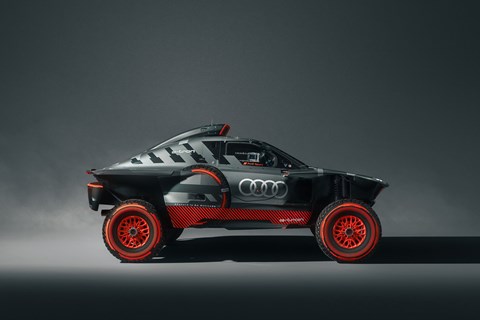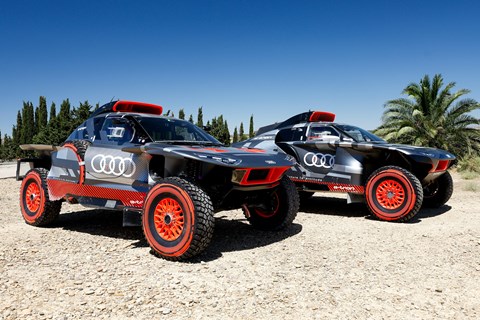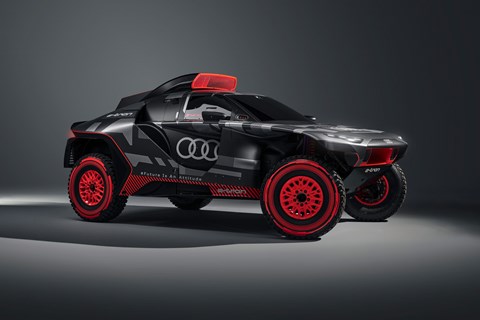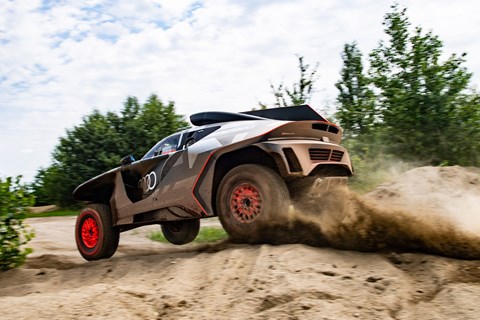► Audi tunes its Dakar rally raider
► RS Q e-Tron mixes Formula E and DTM tech
► Starry driver line-up aiming to prove the tech’s reliability
Audi has just revealed the second-generation of its Dakar challenger in Neuberg today; the RS Q e-Tron. Designed in plug the Formula E-shaped gap until the brand’s entry into F1 in 2026, it’s an electric off-roader, designed to conquer one of the most demanding events in the world.
What’s new with the E2?
Like the previous car, the RS Q e-Tron isn’t wholly electric, and includes a DTM-derived internal combustion engine to help power the battery. The layout is essentially an ICE module and a generator, as well as a high-voltage battery, and an electric motor on each axle. This is four-wheel-drive, of course.
Instead, the biggest change comes from the new bodywork wrapped around Ingolstadt’s innovative powertrain. ‘The Audi RS Q e-tron E2 does not adopt a single body part from its predecessor,’ says Axel Löffler, chief designer of the RS Q e-tron.

Resembling something more sculpted and maritime, the bodywork tapers at the front and rear, reducing both weight, drag and also lowering the centre of gravity – useful on the rolling terrain of the Dakar.
‘The aerodynamic aspect should not be underestimated in desert rallying either,’ says Löffler. Overall dynamic drag has been reduced by 15% compared to the previous car – though the stop speed remains a limited 170km/h.
‘[the improved drag co-efficient] further reduces the energy requirements of the electrically powered car,’ says Löffler. ‘We implemented the aerodynamic calculations entirely using computational fluid dynamics (CFD).’
Want more detail on Audi’s Dakar entrant? Read about the first generation one below.
Audi RS Q e-Tron: the CAR lowdown
 E2 on the left, with the original 2022 car on the right
E2 on the left, with the original 2022 car on the right
Audi Sport has revealed its first ever works entry into the Dakar Rally. The RS Q e-Tron will take part in January’s two-week race around Saudi Arabia, helmed by an all-star driver line-up on a mission to prove that Audi’s electric technology can cope with the world’s toughest race.
The car has three electric motor-generators (based on the Formula E car’s): one on each axle, and a third attached to the 2.0-litre turbo four (from the DTM RS5), to charge the battery (newly developed by Audi).
The wheels are driven solely by the electric motors, not by the petrol engine. There’s no physical centre differential – instead, software does the job of distributing torque between all four wheels virtually.
The 50kWh battery, in the floor of the RS Q e-Tron, is charged by the petrol engine, positioned behind the cabin, and by brake energy recuperation. There will be no charging opportunities during the competitive stages, but there will be generators to charge it overnight.

Work on the project began in June 2020. Audi Sport went public in November with its intention to pull out of Formula E and to return to Le Mans and enter the Dakar for the first time. In March its driver line-up – including Dakar winners Carlos Sainz and Stéphane Peterhansel – was revealed, along with the news that Audi Sport was working on the project with Stefan Quandt’s Q Motorsport, whose X-Raid team has scored six Dakar wins. Off-road testing has already begun in Germany, with Spain to follow, and entries in cross-country rallies.
Project leader Andreas Roos told CAR: ‘With the Dakar you can show what you as a company are really able to do. If we manage to get a fully electric-driven race car into the desert and be competitive and able to race in one of the toughest and roughest environments over long distances, that is the ultimate goal of what we want to achieve, and that is why we decided to take this step.
‘We have a very competitive partner which worked in the Dakar a long time and had several victories in the Dakar. A lot can be learned from Quandt Motorsport. But the car itself is a completely new concept and completely new design. The time we have to build the car and get it ready for the race is very very tight. We are all working on it flat out and hope to get it ready to do all the testing and approvals, that the car is reliable and performing as we want. Then we are looking forward to January, being on the start.’
How realistic would it be to expect an Audi podium?
‘When Audi starts something, we are there to compete. We want to win. We are not there just to be there. We want to prove that the technology is right, so we want to win the Dakar. But we have to be honest. The Dakar is such a rough terrain, and the race is so long, we have 14 days in the desert. You will not be able to win with such a unique and demanding concept right away from the first day. This is a learning year. We want to see what is still needed, where we have some issues, what we still have to do, but in say 2023 we want to fight for victory.

‘Everything that we’ve learned in LMP, Formula E, in DTM, in rallycross, all of this goes into the Dakar project. How you develop a car, this experience always gets used. But the Dakar is something special, so there we also need the experience of people who have done it several times.’
The car tips the scales at 2000kg, without driver and co-driver – the minimum allowed by the rules. Its power output has yet to be finalised, as the organisers and FIA are still negotiating with Audi. Expect a 0-62mph time of below 4.5sec on loose surfaces, and a top speed limited to 105mph.
The design deliberately echoes other Audi cars. The spare wheels are carried in pouches that have a hint of R8 side blade about them. The wheelarches are classic Quattro. The coupe curve of the bodywork is similar to the roadgoing e-Tron GT. The fin is pure Le Mans. And the four-ring Audi logo has been positioned on the roof pod for maximum visibility from the cameras following the cars by helicopter.